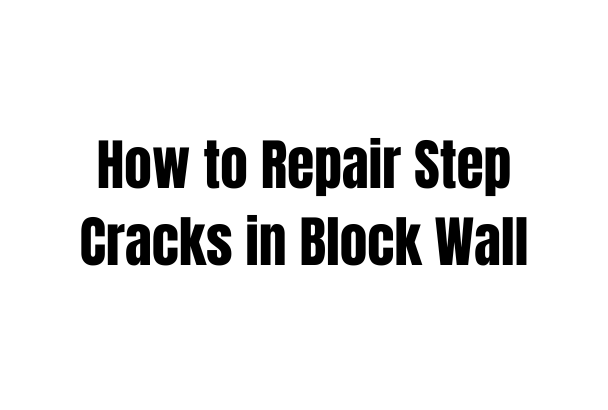The Best Fluffy Pancakes recipe you will fall in love with. Full of tips and tricks to help you make the best pancakes.

Basement foundation walls are often constructed using concrete Block Wall. They function perfectly, but you can’t always tell how the surrounding ground will change or move over time. Occasionally, the earth may compress against the walls or settle beneath them, causing fissures. Although the cracks in the wall can travel in many directions, one type of typical fracture is known as a stair step because it spreads across multiple blocks by following the mortar at an angle. In many cases, this can be fixed, but before you do any repairs, have an expert look it over to be sure the wall doesn’t need to be replaced.
Step-by-step project (6)

First Step
Find fractures and add injection holes.
Try to spot wall fractures in your basement as soon as possible. Although this method will work for fractures up to one inch wide, repair is most effective when the crack is 1/4 of an inch or less.
Put on eye protection and rubber gloves.
Dust, gravel, and other debris on the concrete near the fracture can be removed with a wire brush. If large sections of your wall are flaking off, or spalling, use a grinder with a cup wheel to remove any loose debris.
A crack prep surface paste tube should fit into your caulking dispenser. The concrete crack repair product that is linked is the most efficient that I have used.
Put a new nozzle through the tube. In the event that the crack is vertical, begin at the top.
On both sides of the fissure, dab a tiny bead of paste, about an inch long, onto the concrete.
In order to center a plastic injection port so that it leads straight into the crack, press the port into the paste (it comes with the crack prep surface paste we used).
Install a port every 18 inches along the crack’s length by repeating the procedure.
Read More: How to Fix a Cracked Leather Sofa
Step Two
Cover the crack only slightly.
Apply a thick layer of surface prep paste into the crack, extending the bead along its whole length, to seal the surface. To fill the crack, use as much paste as necessary, making sure it goes beyond the surface of the wall and into the fissure.
Place more thick paste beads one to two inches apart on either side of the crack.
Apply the paste evenly over the crack and the two to three inches of concrete on either side using a paint stirrer stick.
Apply paste to the base plates of each injection port. Make sure the ports remain accessible to the crack.
While the paste is still wet, insert a large wooden skewer into each injection port and move it back and forth. This guarantees that the ports won’t be inadvertently sealed with paste and will remain open. To maintain the passage, remove the skewers immediately.
To ensure that the surface prep paste hardens, give it at least 12 hours.
Read More: Detailed Review of Jemishablunt
Step Three
Plug the hole
With a new nozzle, swap out the surface prep paste tube in your caulking gun for a polyurethane injection solution tube.
Insert the nozzle into the first injection port, starting from the top for vertical cracks and from the left for horizontal cracks, and start squirting the contents through the port and into the crack. Assemble a large supply of injection port caps.
Observe the port that is 18 inches away from the one you are injecting at the next fracture. As soon as you see the second port fill with injection fluid, take the tube out of the first port and cover it with a cap to stop leaks. When you do this, a little solution will still drip out, but once it has set, you can scrape it off and clean up. If you would rather not scrape it up afterwards, you can use some spray foam solvent to clean it up while it’s still wet.
Proceed with the injection procedure at each installed port along the fracture. Spray continuously until the next port displays the solution.
To allow the polyurethane to grow and solidify inside the crack, wait 12 hours.
Step Four
Reclean the area.
Using a hammer, cut off all injection ports.
Put on your mask, safety goggles, and hearing aid.
To remove the hardened surface prep paste and any leftover pieces of the injection ports that have broken off, use a grinder equipped with an abrasive cup wheel designed for masonry applications.
Until the wall has a smooth concrete surface, keep grinding. Use surface prep paste to patch the crack so that it is flush with the surrounding concrete.
Step Number Five
Put on the sticky epoxy.
Dust the area around the crack with a sweep.
Put an adhesive epoxy tube into your caulking dispenser.
Administer dense droplets of epoxy in a precise, zigzag design throughout the fissure, extending approximately five inches on either side. Crack eight feet at a time.
Using a paint roller, evenly distribute the epoxy beads over the 10-inch section of concrete that spans the fracture.
Continue by adding more zigzagging epoxy beads on top of the material you just rolled out. Then distribute the new items as well. That ought should be adequate to create an epoxy coating that is sufficiently thick.
Step Six
Put the strengthening strip in place.
Carefully unroll a length of carbon fiber reinforcing fabric and apply it to the region coated in epoxy. Verify that it is equally spanning the fracture.
Press down firmly by running your paint roller over the entire strip. The epoxy ought to be visible through the cloth. Spread this epoxy evenly throughout the fabric.
Apply additional epoxy to the fabric in a tightly zigzag pattern, then evenly roll it out.
Once more, use cloth and epoxy as necessary to completely cover the crack.
Over the course of the next 12 hours or so, let the epoxy set.
Congratulations! the break in your concrete has been fixed!
In summary:
In conclusion, block wall step fractures can be a major problem that compromise your home’s structural integrity. But you can fix the cracks and stop more harm if you have the correct equipment and know how. Recall to use a masonry saw to enlarge the crack, fill it with mortar, and smooth the repaired area. Don’t be afraid to get in touch with a qualified contractor if you need help fixing the crack. You can make sure your house is stable and safe by taking some easy precautions.
We hope you found this blog post useful. Watch this space for more helpful advice on DIY crack repair, floor, wall, kitchen, and glass crack repair on cracksin.com!







